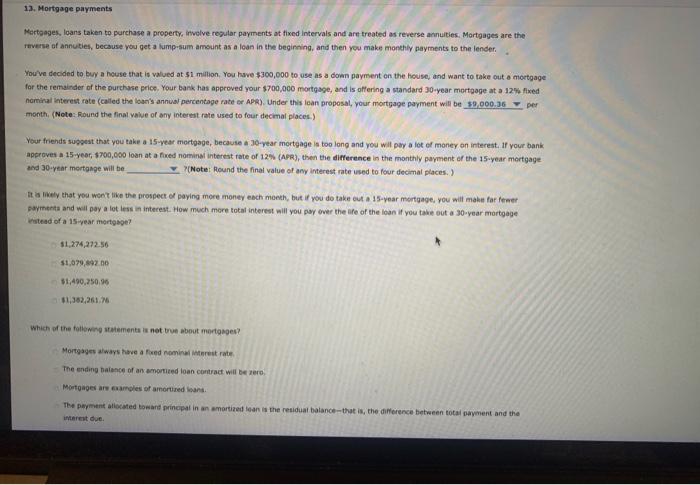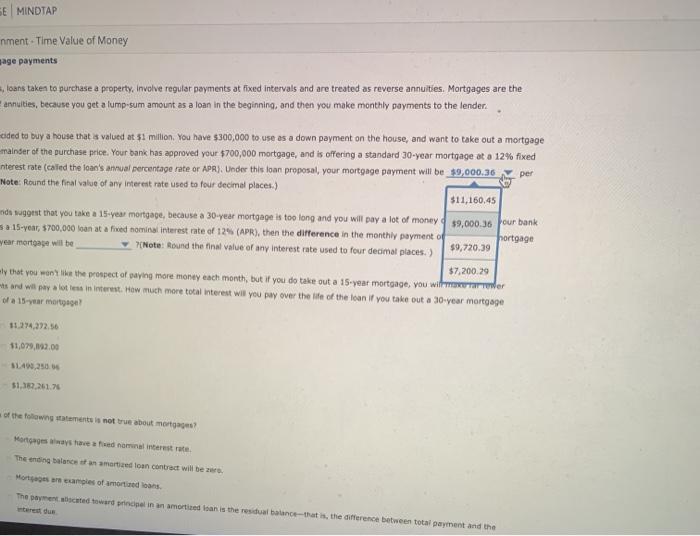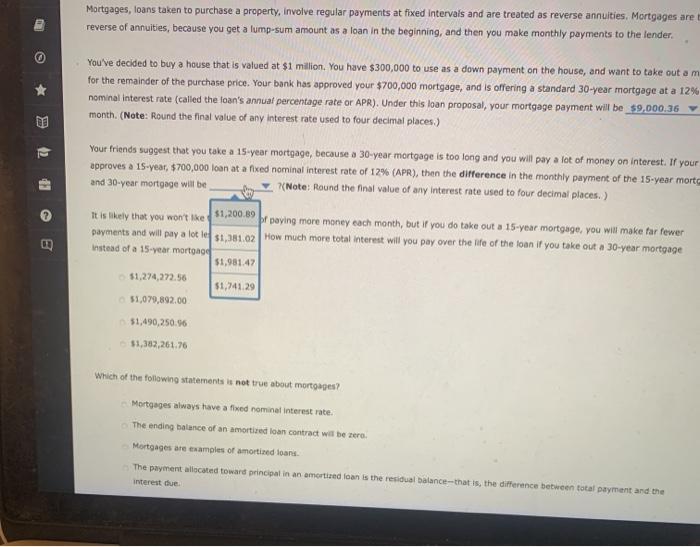13. Mortgage payments Mortgages, loans taken to purchase a property involve regular payments at fixed intervals and are treated as reverse annuities. Mortgages are the Tverse of annuties, because you get a lump sum amount as a loan in the beginning, and then you make monthly payments to the lender You've decided to buy a house that is valued at $1 million You have $300,000 to use as a down payment on the house, and want to take out a mortgage for the remainder of the purchase price. Your bank has approved your $700,000 mortgage, and is offering a standard 30-year mortgage at a 12% fixed nominal Interest rate (called the loan's annual percentage rate of APR). Under this toan proposal, your mortgage payment will be 39.000,36 per month. (Note: Round the final value of any interest rate used to four decimal places.) Your friends suggest that you take a 15-year mortgage, because a 30-year mortgage is too long and you will pay a lot of money on interest. If your bank approves a 15-year, 700,000 loan at a fixed nominal interest rate of 12% (APR), then the difference in the monthly payment of the 15-year mortgage and 30-year mortgage will be (Note: Round the final value of any interest rate used to four decimal places.) It is that you won't like the prospect of paying more money each month, but if you do take out a 15-year mortgage, you will make for fewer payments and will pay a lot less in interest. How much more total interest will you pay over the info of the loan if you take out a 30-year mortgage instead of a 15-year mortgage $1,274,272.56 $1,079,900 31,490,750.95 $1,362,261 Which of the following statement is not true about mortgages? Mortgages always have a fixed nominerest rate The ending balance of an amortized loan contract will be rero Mortgages are samples of amortized and The payment allocated toward principal in an amortized an is the residual balance that is the difference between total payment and the interest du E MINDTAP nment - Time Value of Money gage payments loans taken to purchase a property Involve regular payments at fixed intervals and are treated as reverse annuities. Mortgages are the annulties, because you get a lump-sum amount as a loan in the beginning, and then you make monthly payments to the lender per cided to buy a house that is valued at $1 million. You have $300,000 to use as a down payment on the house, and want to take out a mortgage mainder of the purchase price. Your bank has approved your $700,000 mortgage, and is offering a standard 30-year mortgage at a 12% fixed interest rate (called the loan's atual percentage rate or APR). Under this loan proposal, your mortgage payment will be $9,000.36 Note: Round the final value of any interest rate used to four decimal places) $11,160.45 unds wagons that you take a 15-year mortgage, because a 30-year mortgage is too long and you will pay a lot of money ($9,000.36 four bank a 15-yeur, $700,000 loan at a fived nominal interest rate of 12% (APR), then the difference in the monthly payment of hortgage year mortgage will be (Note: Round the final value of any interest rate used to four decimal places) $9,720.39 $7,200.29 ly that you won't be the prospect at paying more money each month, but if you do take out a 15-year mortgage, you will resorteer s and will per a les in interest. How much more total interest will you pay over the life of the loan if you take out a 30-year mortgage of a 15-year mortgage 11,079,192.00 51,582 261.75 of the following sements is not true about mortgages? Mortgages as a freedominanterest rate The ending balance of an amarted loan contract will be zero Mortgages as examples of mortadan The payment cated toward principal in an amortidan is the residual balance that is the difference between total payment and the Mortgages, loans taken to purchase a property, Involve regular payments at fixed intervals and are treated as reverse annuities, Mortgages are reverse of annuities, because you get a lump-sum amount as a loan in the beginning, and then you make monthly payments to the lender. You've decided to buy a house that is valued at $1 million. You have $300,000 to use as a down payment on the house, and want to take out am for the remainder of the purchase price. Your bank has approved your $700,000 mortgage, and is offering a standard 30-year mortgage at a 12% nominal interest rate (called the loan's annual percentage rate or APR). Under this loan proposal, your mortgage payment will be $9,000.36 month. (Note: Round the final value of any interest rate used to four decimal places.) Your friends suggest that you take a 15-year mortgage, because a 30-year mortgage is too long and you will pay a lot of money on interest. If your approves a 15-year, $700,000 loan at a fixed nominal interest rate of 12% (APR), then the difference in the monthly payment of the 15-year mort and 30-year mortgage wit be (Note: Round the final value of any interest rate used to four decimal places.) It is likely that you won't like $1,200.89 br paying more money each month, but if you do take out a 15-year mortgage, you will make far fewer payments and will pay a lot le $1.581.02 How much more total interest will you pay over the life of the loan if you take out a 30-year mortgage instead of a 15-year mortgage $1,981.47 51.274,272,56 $1,741.29 51,079,892.00 51,490,250.96 $1,302,261.76 Which of the following statement is not true about mortgages? Mortgages always have a feed nominal interest rate. The ending balance of an amortized loan contract will be zero. Mortgages are examples of amortized loans The payment allocated toward principal in an amortized loan is the residual balance--that is the difference between total payment and the interest due









